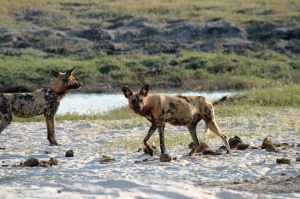
Wild Dogs, Chobe River Nat’l Park, Botswana
Of all the exhilarating, extraordinary wildlife discoveries I have experienced on the African plains, there was none as unique as the African wild dog.
On safari for over two weeks already, we had been hoping to see a pack of wild dogs. But because they never stay in any one place for long and there are very few of them left, we still had not seen them. That day in August was our last possible day to have a chance to see them; after that we’d be in an area where there would be no dogs.
At that point we had watched lions stalking, elephants sparring, hundreds of zebra, a livid cobra, leopard, wildebeest, giraffe, hippos, hundreds of different species–in the perfect glory of their African world. We’d been to South Africa, Zambia and were now in Botswana, but the dogs had still eluded us.
We were slowly riding in the safari jeep on the banks of the Chobe River looking for the elegant sable antelope that our guide had heard was around. Instead we came across a scary old buffalo bull hidden in tall weeds. As he drove, our guide repeatedly and wordlessly opened his door, examining the prints and tracks below in the sand. He was always searching for the dogs. Although wild dogs had not been spotted in this park for five years, they could still show up.
When our vehicle rose over a mound we spotted two, then three wild dogs, lapping water at the river’s edge. Just as quickly as we saw them, they vanished into the weeds. Staying quiet, we knew by this third week, was the only way to see more. Our guide expertly turned the jeep around while he informed us in a whisper that following them was not the answer. The dogs were notoriously fast; their method of killing prey is to outrun and tire them, so the dogs would streak off in an instant and disappear for good if we were to follow them. “There must be more of ‘em” our guide in his Afrikaan British-sounding accent muttered to himself. He told us he was going to head them off, driving in the opposite direction.
Meanwhile everyone in the jeep steadied themselves on the bouncing ride, while scurrying to get out the bigger camera lenses and get set up for what might be, with all our fingers crossed, another opportunity. He zoomed around on hidden tracks and sand patches and within minutes we emerged in a grassy area, he slowed down. After a few quiet minutes of searching, all of us scanning the dirt, sand, and pockets of weeds, we found the pack.
He turned off the motor. There were six of them. They were nuzzling one another, jumping on the backs of each other, breaking off then rejoining again, all in this small circle of dirt.
You can see from the photos that they look like a combination of domestic dog and wild wolf. Their legs are really long and lean, they have a thin fur coat, round ears. Their friendly frolic was familiar, but the fierceness, punctuated with bloody muzzles and manes, was wolf-like. They were marking, yipping and celebrating; another defecated, and there was much sniffing and sneezing.
My human mammal comrades were equally as excited. The camera clicks were rapid and continuous, with nervous and quick adjustments of settings among muted sounds of awe and wonder.
This went on for ten minutes before they ran off and vanished for the final time. Once they were gone we all got out of the jeep and ran over to where they had been, curious and jazzed, looking for their prints, extending the thrill of the visit. It is a funny thing to see mature adults bent down on the ground sniffing and examining the pile of you-know-what that one dog dropped. We all wore big, broad smiles taking in the pure satisfaction of witnessing a pack of the elusive and rare wild dogs.

Impala prey, vultures
Eventually we climbed back into the jeep and decided to look for whatever it was that they had caught and killed. A few minutes later we found a dead, half-eaten impala on the ground, surrounded by opportunistic vultures.
The uniqueness occurred to me later that day as I re-played this event of a lifetime in my mind: that the dogs and us humans, we were all exhibiting the same behavior. All of us, elated about the success of the hunt—shivering, ecstatic joy.




